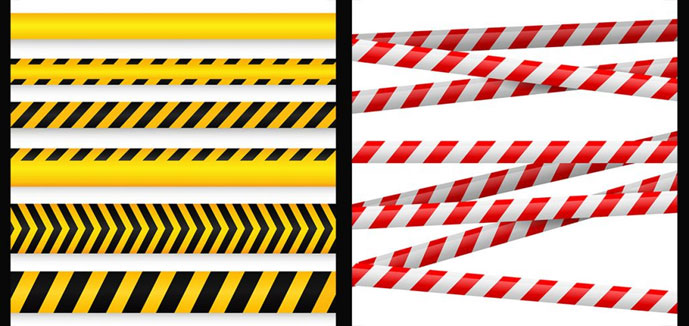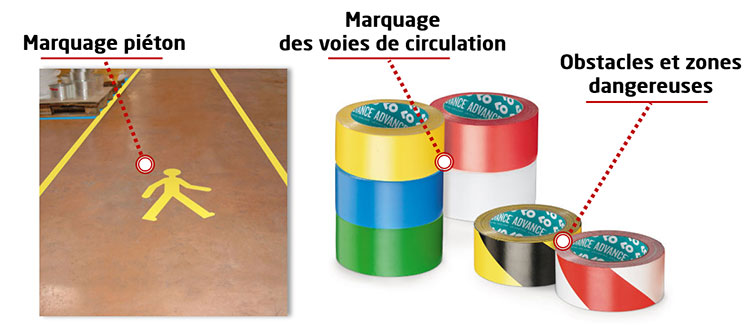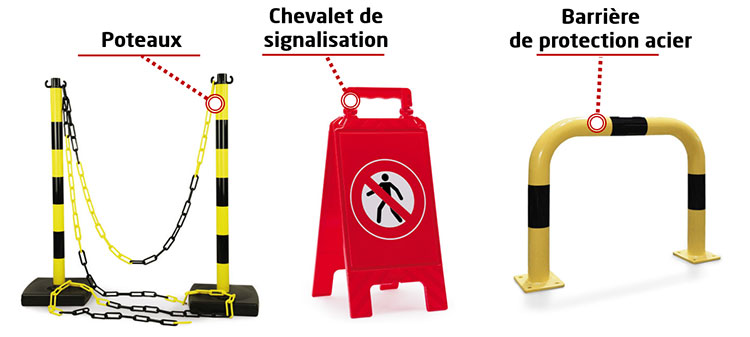Floor marking is used to clearly demarcate work areas in a warehouse. Just as with road traffic, the lines clearly indicate which routes must be followed in the warehouse. As a pedestrian, you know where you should walk, where you can drive your forklift truck and where you should put the pallets. Here we show you everything you need to know about floor marking.
1. What types of tracing are there?
► Single-colour floor marking tape
Single colour tapes or straps are used to mark out areas and clear traffic lanes (for pedestrians or drivers).The floor marking should be visible, with a colour contrasting with the colour of the floor.A minimum width of 5cm is usually recommended.
Floor marking for pedestrian areas (usually yellow) and pallet or machine spaces (also yellow, white or sometimes blue) are often marked in one colour.This is not an official rule, but it is advisable not to be too creative so that it is easier and quicker to recognise.
► Two-colour floor marking tape
Two-coloured ribbons or straps clearly indicate that you are coming up against an obstacle or entering a danger zone
- Yellow/blackindicates a permanent obstacle, such as the space needed to open a door or a loading area on a platform.
- Red/white: this colour combination is universally used to mark temporary obstacles or hazardous locations; the red-white variant is most often used in the form of a webbing, both for recreational purposes and by the emergency services.

2. What are the guidelines for floor marking?
The necessary safety distances between vehicles, objects and people are factors to be taken into account when applying floor marking, and it is the employer’s responsibility to ensure that the employee is aware of the safety and health signs in the workplace and the necessary measures to be taken (see Welfare at Work Code, Book III).
► Instructions for road marking
- The route to be followed by a vehicle in a business should be clearly marked by continuous lines of a clearly visible colour, preferably white or yellow, or a different colour depending on the ground.
- When applying the stripes, you must take into account the safety distances between vehicles that will be moving, but also between pedestrians and vehicles. There must always be enough room to move/turn.
- In an enclosed outdoor area, permanent roads should not be marked as long as they have appropriate fences or pavements.
► Guidelines for marking obstacles and danger areas
- Use yellow and black or red and white tape or webbing. Apply this tape or webbing in all areas of the company to be avoided.
- The yellow and black or red and white stripes on the tape itself should be the same width and at a 45° angle.
- The ground marking should be proportionate to the obstacle or location to be avoided.

3. What does each colour mean?
In the context of workplace safety, each colour has a meaning, and we will review them below
| Red | – Prohibition– Danger(Stop!)– Fire-fighting equipment– Warning(Caution) |
| Yellow or orange | – Warning(Caution) |
| Blue | – Obligation (indication of a specific obligation or action, e.g. wearing personal protective equipment) |
| Green | – First aid (marking of exits, first aid equipment)– Safe place |
4. Marking with tape or paint?
L’utilisation d’un ruban de sol présente de grands avantages par rapport aux lignes peintes. Le ruban adhésif est principalement utilisé à l’intérieur. Contrairement à la peinture, le ruban adhésif peut être appliqué plus rapidement et enlevé plus facilement, et il est moins terne. De plus, le ruban n’a pas besoin de temps de séchage, ce qui le rend immédiatement prêt à l’emploi. Enfin, le ruban de sol peut être déplacé si nécessaire. L’inconvénient du ruban adhésif est que vous dépendez des couleurs et des symboles disponibles sur le marché. Pour les formes spéciales, vous devrez utiliser des gabarits et de la peinture faits maison.
La peinture de marquage est appropriée pour une utilisation en extérieur. Assurez-vous que la surface soit sèche et propre avant de commencer à peindre. Veillez à choisir une peinture à pigmentation renforcée (et donc à opacité élevée) lorsque la surface est soumise à une forte usure. Cela peut être le cas, par exemple, dans les end
5. Temporary or permanent marking?

Le ruban de sol (sans parler de la peinture) n’est pas toujours la bonne solution pour ceux qui ne veulent délimiter une zone que pour une période brève. Il est alors préférable d’utiliser des poteaux de balisage ou des cônes de sécurité. Leurs couleurs vives les mettent immédiatement en valeur. Pour faire ressortir plus clairement les situations dangereuses ou les obligations, vous pouvez placer un chevalet de signalisation pliable au sol. Muni d’une poignée, il est facile à déplacer.
Pour finir, encore quelques mots sur les barrières de protection acier. Les rubans adhésifs ou les sangles ne garantissent pas toujours que les instructions soient suivies correctement. Le ruban adhésif au sol peut ne pas bien se détacher et les sangles peuvent, elles, tomber après un certain temps. Une solution permanente et sûre est d’opter pour une barrière de protection en métal. Elles sont jaunes (avec ou sans bande noire) et peuvent être solidement ancrées dans le sol. Les piétons,
l














